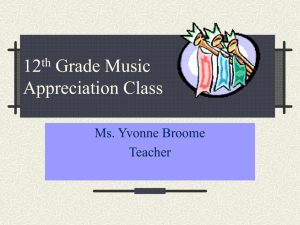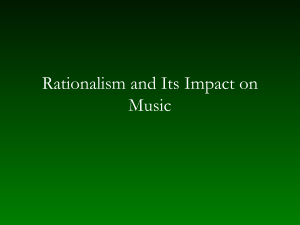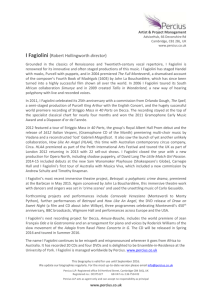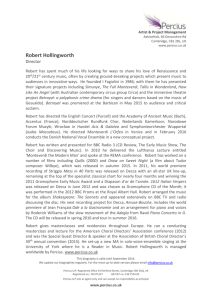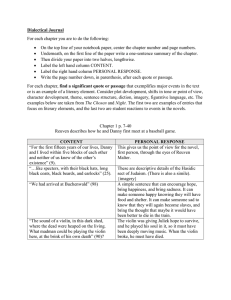“Just as the painter imitates nature, so wind and string players
advertisement
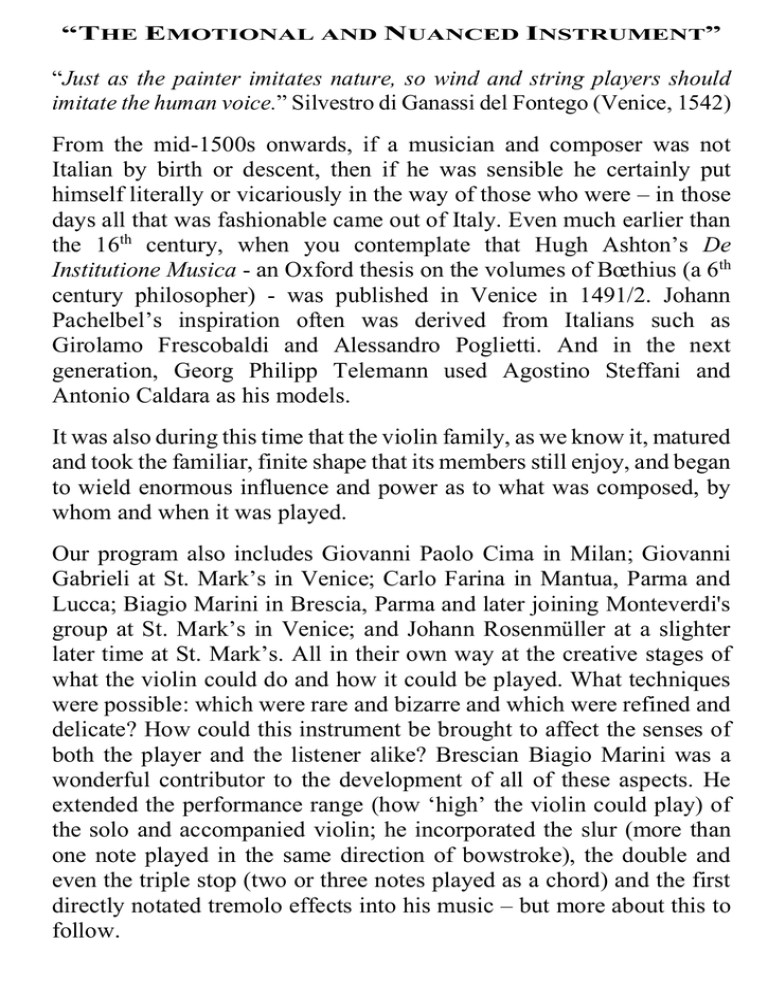
“THE EMOTIONAL AND NUANCED INSTRUMENT” “Just as the painter imitates nature, so wind and string players should imitate the human voice.” Silvestro di Ganassi del Fontego (Venice, 1542) From the mid-1500s onwards, if a musician and composer was not Italian by birth or descent, then if he was sensible he certainly put himself literally or vicariously in the way of those who were – in those days all that was fashionable came out of Italy. Even much earlier than the 16th century, when you contemplate that Hugh Ashton’s De Institutione Musica - an Oxford thesis on the volumes of Bœthius (a 6th century philosopher) - was published in Venice in 1491/2. Johann Pachelbel’s inspiration often was derived from Italians such as Girolamo Frescobaldi and Alessandro Poglietti. And in the next generation, Georg Philipp Telemann used Agostino Steffani and Antonio Caldara as his models. It was also during this time that the violin family, as we know it, matured and took the familiar, finite shape that its members still enjoy, and began to wield enormous influence and power as to what was composed, by whom and when it was played. Our program also includes Giovanni Paolo Cima in Milan; Giovanni Gabrieli at St. Mark’s in Venice; Carlo Farina in Mantua, Parma and Lucca; Biagio Marini in Brescia, Parma and later joining Monteverdi's group at St. Mark’s in Venice; and Johann Rosenmüller at a slighter later time at St. Mark’s. All in their own way at the creative stages of what the violin could do and how it could be played. What techniques were possible: which were rare and bizarre and which were refined and delicate? How could this instrument be brought to affect the senses of both the player and the listener alike? Brescian Biagio Marini was a wonderful contributor to the development of all of these aspects. He extended the performance range (how ‘high’ the violin could play) of the solo and accompanied violin; he incorporated the slur (more than one note played in the same direction of bowstroke), the double and even the triple stop (two or three notes played as a chord) and the first directly notated tremolo effects into his music – but more about this to follow. Around the middle of Claudio Monteverdi’s life (1567-1643), a real revolution occurred in Western Art Music, such as had never been heard of before or since. And where else but in Italy! Up until that time, music was composed with poetry as its impetus. Instruments rarely appeared without voice. Sacred or secular lyrics were written and madrigals (a lyric poem suitable for being set to music, usually short and often of amatory character, especially fashionable in the 16th century and later, in Italy, France and England), motets (a polyphonic choral composition on a sacred text usually without instrumental accompaniment) and masses were composed with their musical expression based on the overall mood of the poem. The inspiration for the composer was not the idea of transmitting the text per se to the listener, but the textual meaning or simply put, the feeling of the poetry. So a love poem, for example, was set so abstractly to music in a multivoice (i.e. polyphonic madrigal, say four parts – the most popular form) that the lover’s dialogue in the poem became an artifice. No one thought of naturalistic discourse or dialogue. Indeed, the (sung) text could barely be understood since the various musical voices were composed in imitation of each other resulting in the simultaneous singing, among the voices, of completely different and conflicting words. These polyphonic works (without their texts) were eventually taken on by instruments, giving non-singers an extensive repertoire, albeit one that was not originally inspired by the sounds and possibilities of the instruments themselves. Thus, this vocal/instrumental mixed-up medium was accepted generally as the basis of the whole of musical life. It was an ‘end stage’ without a perceptible potential for further development; it may well have continued on in this way, well ... indefinitely. But suddenly, at the snap of a violin E string, various musicians in one particular spot on the globe came up with the idea of making language itself, including dialogue, the basis of all music. Music must be dramatic – not just a mellifluous expression of the mood of a poem. As its point of departure, dramatic music took dialogue – its content being based on argument, persuasion, inquiry, affirmation and negation. Born of the belief that contemporary art was inferior to Classical Greek and Roman works, the germ of this idea was, of course, Classical antiquity. It was easy enough to see: visually it lay all about, albeit in ruins. A passionate interest in the Ancients led to the view that Greek drama would have been sung, not declaimed. After all, singing throws the voice further than can the spoken word. An effort was undertaken, by these lovers of antiquity, to revive the ancient tragedies, with the intention of being faithful to the originals. (It is interesting that this new departure was developed by those who believed in the reconstruction of something very old – akin to the current Early Music movement or restoration of an ancient monument.) No one knew, though, how a Greek tragedy would have sounded, so the style had to be invented. The most famous of these dramatic societies, where these musings took place, were the Cameratas of the Counts Corsi and Bardi in Florence. There we find Vincenzo Galilei (1520-1591: the astronomer’s father), Giulio Caccini (1551-1618) and Jacobo Peri (1561-1633) setting the tone as musicians and plotting this new dramatic medium or melodrama. Though the first “Opera” of Peri and Caccini were not musical standouts – more thought-provoking prototypes – the underlying ideas led to a completely “new music” - Nuove Musiche – the title of Caccini’s (1602) impassioned and programmatic work. Together, they shone their combined torches, lighting the way to “Baroque music” – a music which speaks directly. In his writings, Caccini in particular describes quite new forms of expression; a strong aura radiating from the singer is most important to him. Interestingly, he recommends that coloraturas and ornaments of all types be only used where and when they reinforce verbal expression i.e. not as an end in themselves (a later development), or to compensate for the singers lack of “aura” or stage presence. Ornaments, he affirms, were not invented because they are necessary for good singing but rather as “Ear ticklers” for those not capable of performing with passionate intensity. What was fundamentally new in all of this was that text, often a dialogue, was set to music for just one voice, with the rhythm and melody of speech being followed precisely and naturally i.e. “Recitative”. The important, abiding consideration was to render the text as clearly as possible and with the greatest expressiveness. Everything else which had previously been considered as essential was now rejected as being a distraction to gaining the full, clear meaning of the text. The new form derided word repetition, in contrast to the madrigal where words or groups of words are often repeated ridiculously. (In real dialogue, after all, words are only repeated if the hearer has missed something, or when particular word or concept needs emphasis – a practice used in this “new music”.) This Nuove Musiche we term “Monody”. Such an idea was certainly innovative and at first must have been really quite outrageous. Imagine yourself alive in those days – the turn of the 17th century. You are about 35 years old and the music that you have heard since birth has never been anything other than what you have gleaned coming out of a patrician house, heard in a church or, if you are lucky enough, an aristocrat’s palace. It might be the wonderful madrigals of Luca Marenzio (1553–99), the youthful Monteverdi or Flemish composers in vogue, such as Adrian Willaert or Josquin des Pres: highly esoteric and complex multilayered vocal music with instruments playing a capella (i.e. their corresponding parts of each voice type). Now, without warning, someone proposes that the way people speak is in and of itself Music. Indeed, that is the true Music! Again, where else but in Italy, where the language does sound melodramatic! Just stand in a marketplace in Italy or imagine yourself in an Italian courtroom, listening to Italian trial barristers summing up their cases; then you will understand what Caccini and Galilei meant. All that is lacking are a few well-placed chords plucked on a lute, guitar or harpsichord to complete the monody – this recitativo. So, for music lovers – appassionati di musica – whose madrigal dreams were suddenly shattered by monody, this new music had greater impact and came with a greater after-shock than even that caused by the arrival, a century ago, of Arnold Schönberg’s atonal music. In his Nuove Musiche, Caccini claimed that polyphony (the simultaneous combining of a number of parts, each forming a distinct melody and harmonising with each other) and counterpoint (the technique of writing or playing a melody or melodies against itself, according to fixed rules) were the work of the devil, that they only made music incomprehensible. The accompaniment must be so discreet that one is not attracted to it; dissonances should be used pertinently in order to add emphasis to the expression. The parts in his book relating to language, the “melody of speech” and accompaniment are critical to the development of Opera and the recitative, and ultimately the instrumental sonata and concerto. This sensational idea of “Speech as song” only gets interesting for us because it was taken on by a musical genius. Claudio Monteverdi, slightly younger than Caccini, was the greatest madrigal writer of his time; he had mastered every finest detail of counterpoint. Monteverdi, however, did not blindly accept the theories and dogmas of the ‘Caccini club’. He could not, for instance, admit or believe that counterpoint was “Satan’s aural deception”. Nor could he subscribe to the notion that the music would detract from the text if, in its own right, it was interesting! So although he found Caccini’s ideas worth considering, from 1605 onwards, Monteverdi set about to develop his own vocabulary for his music dramas. In 1607, he wrote the still-famous L’Orfeo; in 1608 Ariana. And from then, everything – without precedent – was a kind of experiment. Every short piece, every duet, every trio. He tells us just how aware he was of where he knew he was heading. With the greatest care, he searched for the most effective musical nuance for every affect or emotional state, for every human sentiment and for each word. To quote one example, we hold the magnifying glass over a scene composed in 1624 for the cantata Combattimento di Tancredi e Clorinda. (It was composed for a private entertainment at the Palazzo Girolamo Mocenigo and performed by musicians from St. Mark's Venice, where Monteverdi was maestro di cappella.) For it, he sought a style with which he could express the state of violent anger. “But since I could not find an example for an impassioned mental state in the music of earlier composers ... and since I also knew that opposites move souls the most, something which good music should do, ... I began with all my energy to search for a passionate form of expression ... In the description of the struggle between Tancred and Clorinda, I found the opposites which seemed right for transposing into music: war, prayer, death.” Now, is that really true? Is it in fact the case that prior to 1624, music did not provide the means of expressing states of great passion or great excitement? And given that supply is contingent on demand, was it even unnecessary for music to do so before that time? Fortunately, for you the reader, and me the writer, the research has been done. Well before he died on 6 March 2016, the eminent and celebrated Austrian conductor and music scholar of Concentus Musicus fame, Nikolaus Harnoncourt, was able to conclude that the answer was that apart from one French example - Clément Janequin's La Guerre (1528) - “No: the lyric art of the madrigal contains no outbursts of rage and no states of great excitement either positive or negative.” So, Monteverdi did have to invent the means of expressing such emotions. Being familiar with classical philosophers, he looked to Plato; there he found repeated notes. “I therefore investigated the fast tempi, which according to the leading philosophers originated in an excited and martial mood ... Then I discovered the effect for which I was looking. To accompany words that expressed anger, I divided the semi-breve [w] into 16 semi-quavers [], each of which is to be individually struck.” [Preface to Monteverdi’s 8th Book of Madrigals, published 1638] This he named stile concitato (the agitated style) and from this point on, agitated emotional states being represented by rapid note repetition became a familiar device, both for musicians and listeners. For the remainder of the 17th and the entire 18th centuries, it was equally used for instance by Handel and Mozart, as well as composers on our program such as Farina, Marini, Venturini, Rosenmüller and Telemann. Monteverdi writes that at first the musicians threatened industrial action: What’s this? The very same note sixteen times in one bar? What an insult to be required to do something that until then seemed so musically senseless. Any ninny can move the bow back and forth over the string but that is not music! And, after all, note repetitions are ‘not done’ in strict contrapuntal writing! So, Monteverdi had a bit of fast talking to do: he had to explain that this device was imbued with extra- musical meaning relating both to the drama and the human body. It was a new, purely dramatic and physical element. From then on, repeated notes were only used to achieve certain effects – usually to do with heightened emotional states. Many Classical symphony movements, for example, contain what became known as a “drum bass”. Such movements are composed over stereotypical repeated quaver notes played by the bass instruments – and sometimes the viola playing the ‘basso alto’ (high bass). The result is a strong feeling of increasing tension and excitement springing from such accompaniment. (One of the joys of being a bass instrument player is to be the one underpinning that tension.) Often in the performance of music today, repeated notes are just repetitions of the note or chord and do not express anything. In addition to types just described, another nuanced kind of repetition has existed since the early 17th century – tremolo approximates vibrato and is a nuanced device of expression. As employed by Biagio Marini, in one bow stroke a throbbing, articulated repetition of notes of the same pitch is played to represent sorrow and death. Like Biagio Marini, Carlo Farina is considered to be one of the earliest violin virtuosos, making many contributions to violin technique. For example, in his work Capriccio Stravagante (1627) he used the violin to imitate animal sounds like dogs barking and cats caterwauling. Ten years later, Marin Mersenne in his l'Harmonie universelle (1637) “affirmed the violin's specific strength as its versatile ability to adopt the timbre and musical idioms of other instruments, as demonstrated in Farina’s Capriccio”. It is almost impossible for us to imagine a time when instruments were relegated to second place behind voices. But it is thanks to the turn-ofthe-17th century, overnight simplification of musical texture – that vocal/instrumental mixed-up medium of one part imitating another that was characteristic of the Renaissance – and the innovation of monody that we have instruments in their own right not only imitating the voice but exploring, in their own way, the emotional extents of the human character. © Tim Blomfield 2016
